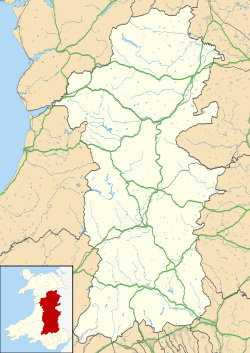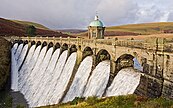Powys | |
|---|---|
| |
| Motto(s): | |
 Powys shown within Wales | |
| Coordinates: 52°18′N 3°25′W / 52.300°N 3.417°W | |
| Sovereign state | United Kingdom |
| Country | Wales |
| Incorporated | 1 April 1974 |
| Unitary authority | 1 April 1996 |
| Administrative HQ | County Hall, Llandrindod Wells |
| Government | |
| • Type | Principal council |
| • Body | Powys County Council |
| • Control | No overall control |
| • MPs | 2 MPs |
| • MSs | 2 MSs
|
| Area | |
• Total | 2,000 sq mi (5,181 km2) |
| • Rank | 1st |
| Population (2022)[2] | |
• Total | 133,891 |
| • Rank | 11th |
| • Density | 70/sq mi (26/km2) |
| Welsh language (2021) | |
| • Speakers | 16.4% |
| • Rank | 7th |
| Time zone | UTC+0 (GMT) |
| • Summer (DST) | UTC+1 (BST) |
| ISO 3166 code | GB-POW |
| GSS code | W06000023 |
| Website | www |
Powys (/ˈpoʊɪs, ˈpaʊɪs/ POH-iss, POW-iss,[4] Welsh: [ˈpou̯ɪs]) is a county and preserved county in Wales.[a] It borders Gwynedd, Denbighshire, and Wrexham to the north; the English ceremonial counties of Shropshire and Herefordshire to the east; Monmouthshire, Blaenau Gwent, Merthyr Tydfil, Caerphilly, Rhondda Cynon Taf, and Neath Port Talbot to the south; and Carmarthenshire and Ceredigion to the west. The largest settlement is Newtown, and the administrative centre is Llandrindod Wells.
Powys is the largest and most sparsely populated county in Wales, having an area of 5,181 km2 (2,000 sq mi) and a population of 133,891 in 2022.[2] After Newtown (11,362), the most populous settlements are Ystradgynlais (8,270), Brecon (8,254), and Llandrindod Wells (5,602). The county is entirely rural, and characterised by multiple market towns and villages. The Welsh language can be spoken by 16.4% of the population.[5]
The county is predominantly hilly and mountainous. To the west lie the Cambrian Mountains, where the River Severn and River Wye both have their source on the Powys side of the Plynlimon massif; together with their tributaries they drain most of the county. The southern quarter of the county is occupied by the Brecon Beacons (Bannau Brycheiniog) national park, and further north are two more upland areas, Mynydd Epynt and Radnor Forest. The only extensive area of flat land in Powys is the region northwest of Welshpool.
The county is named after the Kingdom of Powys, which was a Welsh successor state, petty kingdom and principality that emerged during the Middle Ages following the end of Roman rule in Britain. Powys covers the same area as the historic counties of Montgomeryshire, Radnorshire, and Brecknockshire.
- ^ "Council Information". Powys County Council. Retrieved 6 August 2024.
- ^ a b c "Mid-Year Population Estimates, UK, June 2022". Office for National Statistics. 26 March 2024. Retrieved 3 May 2024.
- ^ "How life has changed in Powys: Census 2021". Office for National Statistics. 19 January 2023. Retrieved 6 August 2024.
- ^ "Powys". Collins English Dictionary. HarperCollins. Retrieved 6 August 2023.
- ^ "How life has changed in Powys: Census 2021".
Cite error: There are <ref group=lower-alpha> tags or {{efn}} templates on this page, but the references will not show without a {{reflist|group=lower-alpha}} template or {{notelist}} template (see the help page).



